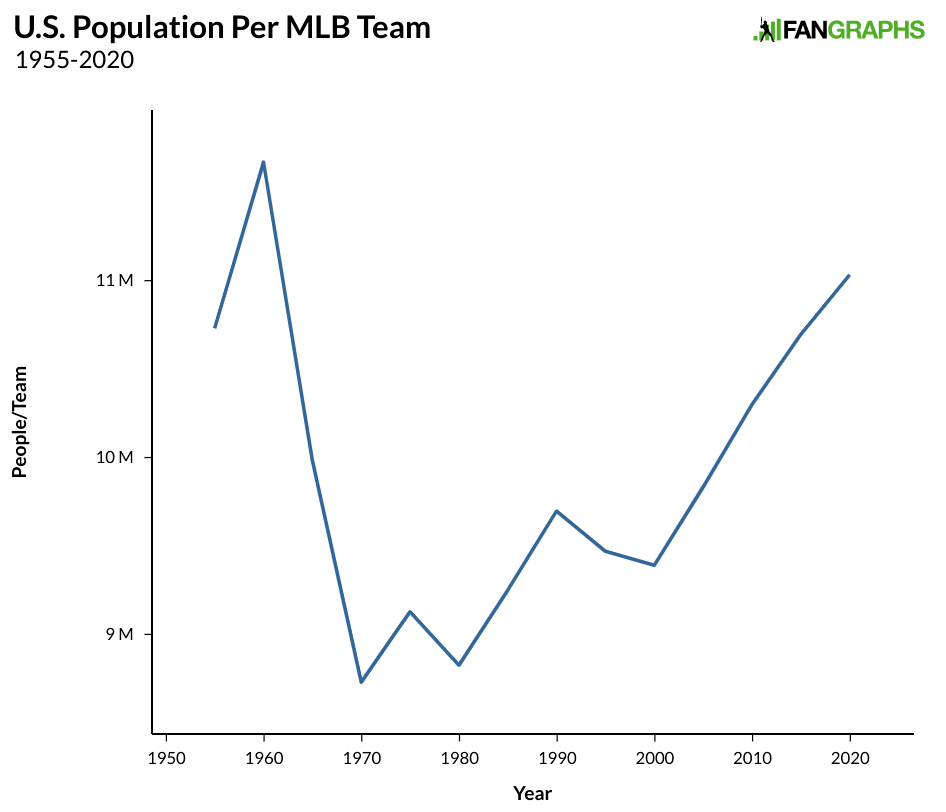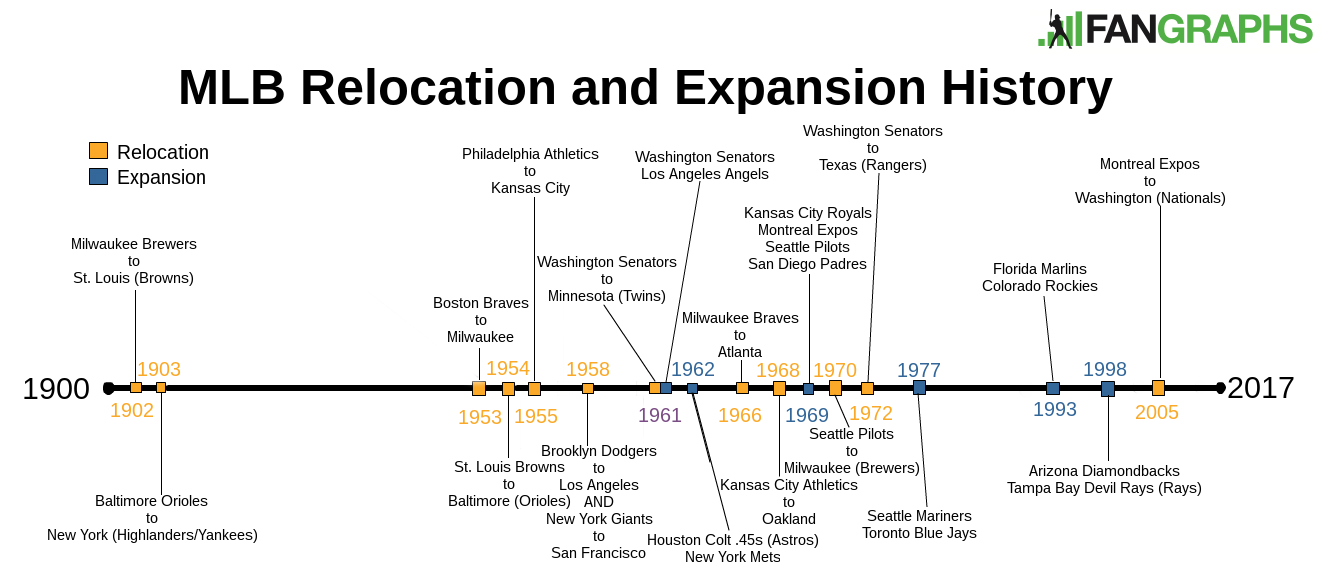Will MLB Turn to Expansion After Losing Revenues to COVID-19?
Over the last several decades, revenues for Major League Baseball have soared, nearing $11 billion last season. The league’s unprecedented prosperity has turned MLB franchises into cash cows in ways not seen in prior generations. It will likely take some time to gauge the extent of the revenue teams will lose due to COVID-19-related delays, but given that some or perhaps all of the 2020 season will be lost, baseball isn’t likely to be a great moneymaker for owners this year. And while league expansion has been talked about for quite some time, it’s possible the losses suffered this season due might actually be the precipitating factor in MLB moving beyond 30 teams.
For the last few decades, owners haven’t felt compelled to expand because they were making plenty of money without the need for a cash grab. The dirty truth about expansion is that it isn’t about growing the sport. It’s about injecting cash into ownership pockets now, with those same owners willing to share a slice of their pie with a couple more teams in the future. If the owners don’t feel the need for that expansion money, they aren’t going to welcome more teams to take a share of overall MLB revenues. In addition, the threat of relocation from teams looking for new stadium deals serves to slow expansion; MLB likes to have potential expansion cities available to threaten municipalities into providing new ballparks.
Modern expansion isn’t about the talent levels available or growing to meet the needs of an increasing population. If it were, we would have seen expansion at some point in the last decade. The talent pool has gotten incredibly good, with fastball velocities and strikeout levels rising to the point that diluting the talent pool could have a positive impact on the game, resulting in more action and balls in play. And in terms of population, the number of people per team is approaching levels last seen in 1960 when baseball had just 16 teams. The graph below shows the U.S. population and the number of major league teams in five-year intervals, to show how the number of people per team in the U.S. has changed since 1960:

Since MLB moved to 26 teams in 1977, over 40 years ago, there have been just two rounds of expansion, both taking place in the 1990s. The timeline below (from this piece) shows MLB’s history of expansion and relocation:

From 1961 to 1977, baseball added 10 teams, then waited another 16 years before adding four teams over five years. In the 22 years since, there have been no further additions. As for what spurred on the expansion in the 1990s, we might surmise that establishing a presence in growing markets in Colorado and Arizona, as well as a big market down in Miami, could have been pretty big factors. But the most significant driver might have been owners’ desire for some cash. The franchise fees in Miami and Denver totaled $190 million, though that money went disproportionately to National League teams. In 1998, the franchise fees had moved up to $260 million in total with an additional $50 million in forfeited revenue over the first five years of the teams’ existence. The 1998 expansion teams began paying their franchise fees in the middle of the 1995 season.
As to why teams wanted those franchise fees, the strike in 1994 might come to mind, particularly for Arizona and Tampa Bay. But the 1993 expansion preceded the strike, and the official exploration for the 1998 expansion began prior to the strike. According to former Commissioner Fay Vincent, the reason for that expansion was that teams needed money to pay their $280 million collusion settlement. From 1985-1987, teams colluded to suppress free agent salaries down, and the resulting settlement to resolve the issues amounted to $280 million, which needed to be paid before the 1991 season began. Vincent had this to say about the settlement — and the resulting expansion — in a 2005 interview:
Look, each owner had a $10 million bill and there were about 26 clubs before expansion and 30 at the moment, then $280 million, let’s say $10 million a club – they didn’t have the money. So they did what most would business do, they sold stock, they sold interest in the clubs, in the expansion clubs. In my day two of them – Miami and Denver. And that money, which was vital, paid off their collusion debt. Without it I think baseball would have had a very serious time. Indeed some of the clubs had had a serious time financially, a number of them were in tough shape…I suggested that instead of expanding, we move two clubs, one to Denver and one to Miami…I remember one of the owners said, “That’s the single dumbest idea I’ve ever heard!” But what he was really saying is, “We need the money to pay off the union because we colluded.”
When we look at the past two decades, we’ve seen baseball revenues grow, leading to more profits. We’ve also seen a windfall in the form of the sale of BAMTech that was paid to ownership; the sale of BAMTech to Disney meant payments of around $80 million to every team. Of late, we’ve also seen MLB approve investment funds taking minority interests in teams, as Ben Clemens wrote about last fall. Those investments allow owners to receive a cash infusion in exchange for giving up a small share of their club. However, every owner might not be in a position to sell off parts of their team, and some owners may wish not to let investment firms get involved with ownership. Expansion might be the only viable avenue many owners have to recoup some of the expected revenue losses this season.
Depending on the particulars and the investment necessary for a stadium, we might see a franchise fee anywhere from $750 million to $1.5 billion should new teams be formed. The Kansas City Royals just sold for $1 billion, while the Marlins sold for $1.2 billion in 2017. Even adding just two franchises totaling $1.5 billion in franchise fees would net every owner $50 million, and those payments could begin several years before the new teams actually debut. Of course, new stadiums would obviously (and appropriately) be major hurdles to new teams, as is seeing some stabilization of the sport and the economy at large. A new franchise, and the construction of a new ballpark, is almost certainly not where most municipalities will elect to devote their logistical and financial resources right now. But the easiest way to make up for some of the losses in 2020 might be to add a couple of teams in the next few years.
Expansion is an oft-covered subject here at FanGraphs and The Hardball Times, with Jeff Zimmerman detailing the need, Chris Mitchell discussing the potential locales, and Travis Sawchik building on the work of Jay Jaffe (then at Sports Illustrated) when he discussed how expansion might look. Adding more teams is a great way to create new fans and put more great talent on display on the biggest stage the game has to offer. It’s possible, due to some truly awful circumstances, that baseball’s owners finally have the financial incentive to make it happen.
Craig Edwards can be found on twitter @craigjedwards.

Carolinas is the most obvious place, mlb needs to tell the braves to f off and give up their hold on the deep south